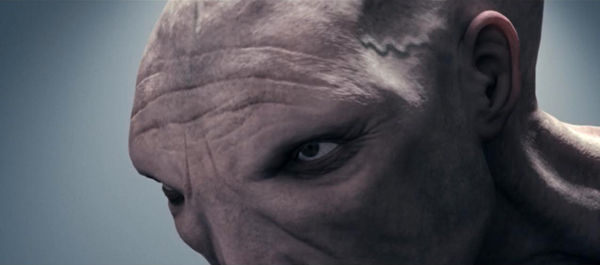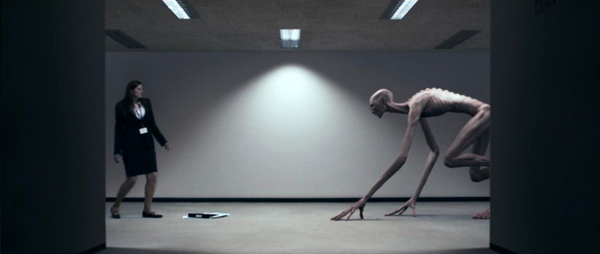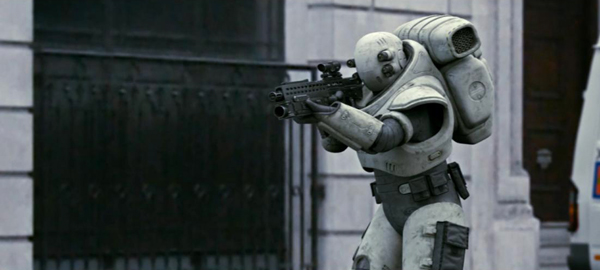
AEAF WINNER - SHORT FILMDirector, writer and digital artist Matt Westrup talks about making his short film, ‘The Gate’, from concepts through the shoot and detailed post production.
| ‘The Gate’ is a science fiction short film describing a series of alarming incidents in the UK related to the use of unregulated pharmaceuticals, privately obtained by individuals though unidentified websites, resulting in several horrible deaths. The viewer learns about the events as the camera cuts between the proceedings of an official inquiry and two chilling sequences revealing the nature of the victims’ condition. | |
 |
|
|
Maintaining Realism Most of the footage was shot on a RED camera, plus some handheld scenes were recorded on Panasonic and Sony HD cameras. Matt split the cinematography duties between two DPs who both have experience dealing with effects work and knew how to light green screens and so on. He wasn’t looking for huge dolly moves or sweeping camera shots. Instead, shots were intentionally either locked off or handheld as a way to maintain realism throughout the film. He also acted as his own VFX supervisor on the shoots, allowing him to discuss the shots one-to-one with the DPs. “The office scenes towards the end of the film were especially tricky,” he said. “Because the budget was tiny for this short and as a result I couldn’t get the exact location I really wanted for those shots. As a result, I spent three months in post building set extensions and rotoscoping actors to make the corridors much more lavish than they really were. “I had to restrict my coverage, which I don’t like to do, and keep the camera movement to a minimum for the office shots to ensure that the extension work on those shots was kept to a minimum. Tracking markers didn’t always work either, so the more handheld-style shots had to be hand tracked, too. Other than this workaround, the look of the film was always driven by the sense of realism that I was trying to achieve. Location Scouting |
|
 |
|
|
Matt did not carry out any previs, but storyboarded the shots he wanted ahead of time and scouted locations for all sequences. As mentioned, the office sequence had to be worked out carefully in advance. He prefers not to shoot with so many restrictions but, again, the because the location wasn’t ideal, he needed to work out camera angles and positions ahead of time and then plan whatever set extension work would have to be done as a result. For the location of the street sequence, he used Google Street View to get a shortlist of the sort of look he wanted, and then did a live recce to make the final choice. The story calls for several different creatures to be designed, modelled, animated and composited into the live action plates, and look both horrifying but real enough to reach out and touch. It was important that the creatures were never overtly monster-like, which would have started to break the illusion of reality and given the wrong tone to the film. “I did, however, want them to look disturbing and have vestiges of human features,” Matt said. “They are essentially grossly deformed human beings and I was careful not to put too much fantasy into their design. I wanted to suggest that some traces of their former selves were revealed in their behaviour as well, and so it was important that they weren’t simply rampaging monsters.” Creature Design |
|
 |
|
|
“The designs are purposely different for a couple of reasons. First, I didn’t want to show the same creature over and over. I think it would have been obvious that only one CG model had been created and it short changes the audience. Second, each creatures’ design is, in a subtle way, semi-representative of the personality of the human they once were. For example the street ‘primitive’ is meant to suggest that its former self was very aggressive and impulsive, whereas the skinny creature at the end is more intelligent and curious.” The fact that the creatures are actually people who have undergone a dangerous mutation makes their remaining human traits more alarming. The eyes of the creatures we get to see close up – such as in the hallway and lift of the office building – are human eyes. All still have human skin and hands and one has a human mouth and teeth. “I have always thought that something that isn’t too far removed from being completely human is actually more disturbing than a lavishly designed creature and that seemed to be the most appropriate approach. It was important not to go too overboard and push the mutations too far,” Matt said. Medical Machinery In the course of the inquiry, a video is shown comprising medical imaging and footage of automated clinical equipment examining the mutated victims. Matt co-designed the white, clean room and MRI machine with my brother, a concept designer. The film is loosely set some ten years from now and the designs are intended to represent what the equipment might look like at that time. “We looked at current medical machines and devices and designed our models to look derivative of the latest technology,” he said. “Some level of familiarity was needed for the audience to buy the reality. If the design had been outlandish, it would suddenly have become too much like ‘sci-fi’. We added lots of real but embellished MRI scans and x-ray images to those sequences and, again, all to try and sell an illusion of reality.” City of London “Audiences are very used to seeing SWAT teams in black outfits for this kind of set piece but I wanted to have something more visually interesting on screen. The film is set some ten years from now and so the idea behind the suits is that the military wear this gear to safely diffuse IEDs [improvised explosive devices] and deal with chemical weapons in on going overseas combat.” When it came to shooting this sequence, he went into London at 4am on a Sunday morning with his production manager to ensure the best chance of finding a quiet street. Budget precluded the use of a crew, which would also have meant obtaining street licences. Working from his own storyboards, he captured handheld footage of the totally empty street with a consumer level HD cam. He also chose an overcast day, wanting a slightly gloomy mood. Technically, it’s also easier to light the shots without strong shadows to match in with the plates. Sense of Chaos All of the police vehicles, soldiers, the creature and helicopter were added in post as CG elements. “Some of the shots didn’t track too well, so I had to find work arounds by splitting the shots in the VFX edit and adding insert shots. Some additional handheld and zoom camera effects were added in post for some of these shots, too.” Like the medical equipment, Matt also felt the helicopter design, modelling and animation, should be somewhat familiar to the audience, and based it on the V22 Osprey and the Sikorsky Sea Stallion which are both big, military helicopters that look exciting on screen. “Once I had designed the chopper the modelling was fairly straightforward,” he said. “The animation was fairly simple because it is either hovering or moving in straight lines, but the motion blur on the propellers wasn’t really giving me the results that I wanted, so I opted to use image maps on a disk and an alpha channel to add transparency in the correct places. Staging Drama As the creature leaps onto the police van from behind, runs down the street, is shot and lies prone on the street, panting and defeated, the drama reaches a peak. “It was important that the audience knows that the creatures are being tranquilised to spare them from an inevitable and traumatic death, rather than just being gunned down,” said Matt. “It reinforces that they are dying human beings and not just rampaging monsters. This had to be shown clearly and that’s why we see the darts hit the creature and then cut to seeing it weaken and fall unconscious. The most challenging part of the shot was the matchmove. Handheld footage from a consumer level HD cam has its limits for VFX work and it proved to be a real headache getting a track from the footage.” |
|


















